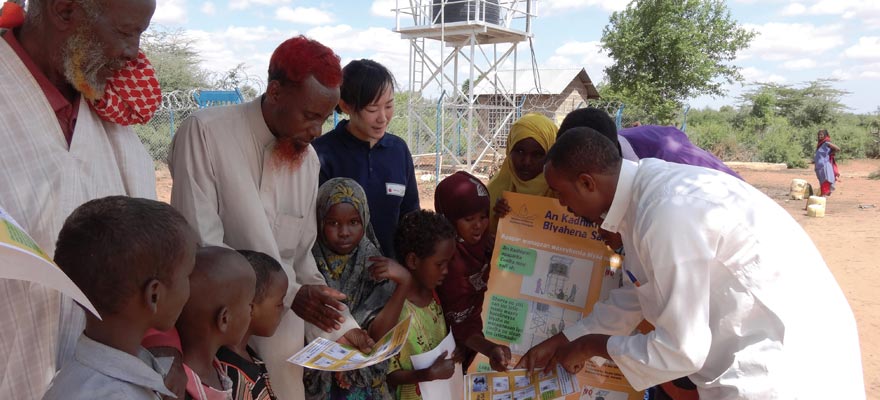Home > Highlighting JAPAN >Highlighting Japan February 2014>Living with water
Highlighting JAPAN
Living with water
Powering the Water of Life
AAR Japan brings sustainable water to a vulnerable region

In a region where safe water is extremely difficult to access, and where even aid cannot easily be provided, there is one organization that continues to work to protect the health and lives of the local people.
In 2011, East Africa experienced its worst drought in 60 years. At the same time, ongoing fighting in Somalia sent refugees fleeing across the border to Kenya's Garissa County, an area about eight hours' drive from the national capital of Nairobi. In a region already struggling with limited water resources, this created a perfect storm for a humanitarian crisis.
Accommodating as many as 500,000 people, Garissa's Dadaab refugee camps are recognized by the Office of the United Nations High Commissioner for Refugees (UNHCR) as the world's largest refugee settlement. "The people there jokingly refer to it as the third-largest 'city' in Kenya after Nairobi and Mombasa," says Go Igarashi, who has made multiple trips to the region as a program manager for Association for Aid and Relief, Japan (AAR Japan), a U.N.-recognized Japanese NGO.
Many of the refugees and their local hosts rely on a nomadic, pastoral economy and have little money to purchase water from the wells – where many pumps are out of order to begin with – or from trucks selling expensive water. Meanwhile, the local villagers' only options for free water include digging three to four meters into the mud of dried, seasonal riverbeds or embarking on a several-kilometer trek to the Tana River. Water collected in such environments has a high risk of contamination by diseases that may cause diarrhea and other infectious conditions. Moreover, Igarashi was stunned to hear villagers casually mention that when they were children, several of their friends were eaten by crocodiles when they went to get water from the river. In Garissa, obtaining water is the work of women and children.
In August of 2011, AAR Japan decided to initiate humanitarian intervention efforts in the Garissa region, and Igarashi was one of the first staff members involved. A rapid decline in security a few months later forced the staff to relocate to the city of Kitui, where they began constructing a 17-km pipeline to bring water to four different water kiosks. Overcoming project delays and leaking pipe joints, Igarashi says he and his staff were "overjoyed when the first trickle of water sputtered and then suddenly started flowing out from the tap."
With the situation in Garissa stabilized, AAR Japan returned in February 2013. In areas such as the village of Nadir, the organization's crew of two Japanese expatriates and five local staff members worked with Kenyan engineers to establish water facilities both by repairing existing wells and digging new ones. They also constructed a new water tower system in the region.
Hand pumps, they discovered, were an imperfect solution for highly populated places such as markets in town centers. As simple as the pumps might have been to install or repair, they were easily broken, creating what Igarashi describes as "a repeating cycle of damaged pumps." Other wells utilized motorized pumps, but these were also susceptible to breaking down and, more importantly, required gasoline or diesel to operate – expensive resources for locals.
The Kenyan government recommended using solar panels to power pumps that could be used to store up to 10,000 liters of water in a single tank. Recognizing this model was both more sustainable and would reduce maintenance costs, AAR Japan adopted this approach.
The locals are now grateful not just for the water but also for the time they save. Having low-cost water close by has given women new freedom in their daily routines, while children who once spent several hours a day gathering water now have the time to attend school and play with their friends.
AAR Japan's work in Garissa extends beyond the installation and repair of water facilities. Recognizing that resident participation will be essential for maintaining the function of the water supply system, AAR Japan assists local communities in setting up water management committees to educate other locals about basic hygiene as well as maintenance and facility management, such as working out procedures for collecting the nominal fees charged to water users for the cost of future maintenance.
The drought may have passed, but the specters of further droughts and increasing water needs always loom on the horizon. AAR Japan is continuing its work in Garissa to keep the water flowing for a sustainable future.
© 2009 Cabinet Office, Government of Japan






